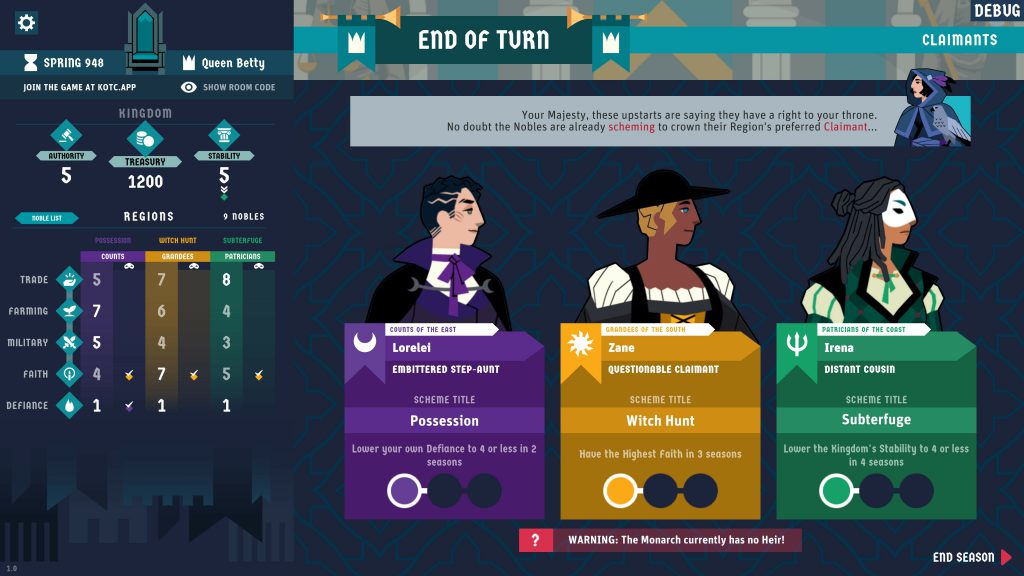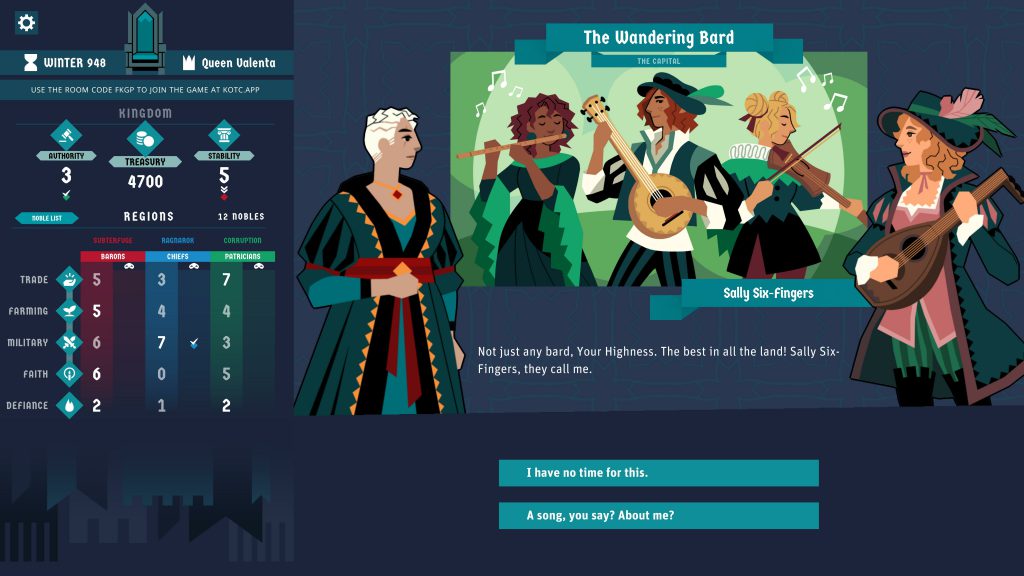King of the Castle challenges a monarch to control hundreds of rebellious, player-controlled nobles
King of the Castle is a multiplayer narrative game, one optimised for large groups of players, or massive Twitch audiences.
Narrative and Multiplayer aren’t two things that tend to go hand-in-hand when it comes to game design. In fact, narrative (as a gameplay element, and as a genre) tends to be quite a personal thing to the player — especially in choice-led games like Telltale games, Point & Click adventures or word-heavy titles like the Choice Of or Sunless series. Confusingly, then, King of the Castle is multiplayer by design, with all bar the first player (the monarch) taking on the role of nobles of the realm using their phones to dial in and vote. These nobles have their own agency, an agency decided entirely by themselves, but often revolving around getting their faction to greater power or even to the throne.
It sounds like utter chaos, but somehow Tributary Games have managed to keep the whole thing sleek and approachable. Each noble has the chance to vote on decisions, as they form a monarch’s council, and the choice with the most votes is what goes forward — a system that works with an audience of three through to an audience of three thousand. Some decisions, like the first in the game, simply set a narrative, however, there’s quickly the chance to enhance your own faction’s standing, or cripple your opponents.
At the preview event that we attended there were three factions ruling under the monarch; the ‘Sexy Vampires’, a cluster of hopelessly romantic, pasty, slim nobles of the East; the Patricians, a trade-obsessed collective in the South; and a gruff, war-obsessed clan of the North. Two other factions were available, equally playing off narrative archetypes, but we didn’t get time to experience them.

King of the Castle includes a mass of words, lines and events (I heard the number 900’000 bandied about) with events and storylines fed into the game depending on the factions that are currently in play, the stats of those factions and the previous actions of the players. Each faction felt very different, and the archetypes allowed for quite a bit of self-aware humour to be slid into what could have easily been a very dry, competitive experience.
Each run begins with the monarch selecting an ambition and a reminder that they should start moving to secure an heir, shortly after that each faction is given the chance to select their first goal. The first faction to complete three goal milestones — which are based on moving tracked stats to certain levels through tactful voting — successfully deposes the King and, essentially wins. An example goal is Ragnarok, where the Northern faction must raise their military strength to near maximum (it’s already close), then after that must start weakening the other factions.

This is where King of the Castle starts to shine, this whole thing is all visible. There is no secret plotting. Each player is watching the monarch make decisions, and they’re often in conversation too. The monarch will actively want the factions to fight among themselves, or at least to agree that it’s better to keep the current monarch than have another faction take power. At the preview event, our King tried to play us against one another, telling us that other factions would want us to vote for certain options, and using their limited extra options to try and steer us toward helping them. After a time a monarch can veto, or even ‘Pick a Favourite’ option, which in turn grants cash to the players who vote that way. That’s right, unexpectedly, each player has their own treasury. This treasury is used for events or for end-of-season bidding on buildings that can improve the stats of the faction.
The stats are the central purpose of the game. Almost always visible, each faction has Trade, Farming, Military, Faith and Defiance stats, while The monarch has a Treasury, Authority and Stability stat. As you can imagine, these can all play off each other, and the monarch will want to keep defiance low and their own stats high. That’s hard to do though, as each player is often out for their own faction… ergo the monarch has to become a negotiator, keeping the factions fighting each other while they themself thrive in the chaos. What was interesting was that there was no set representative for each of these factions, meaning there was a kind of silent agreement between members; I can’t describe how satisfying it was when my entire faction voted for the same thing as me, because they could plainly see the same path to victory as I could. That said, sometimes the majority of players simply aligned to spite The King which was equally fun.

During the event, we did have some issues with either the web service or just the WiFi. It was a room of over 50 people, and occasionally you’d time out from your phone going on standby, or log out… however there is still time before launch for this to be ironed out. On that note, details about the player count remain a little up in the air: the Steam page currently says 3–24 players can join locally, and up to 3000 using a Twitch command & chat combination, however, we had over forty players dialling in locally to aid/hinder the effort of the monarch. Some clarification is needed there, but regardless of the numbers, it’s impossible to deny the economic killing that comes with entertaining up to 3000 people with one purchase.
To have that many people entertained, and feeling like they were playing an important role in a narrative, is something that I simply don’t think has been achieved before, and while King of the Castle might ultimately choke without a single-player or bot-driven mode, it’s a phenomenal and exciting accomplishment.
King of the Castle will launch on PC, via Steam, on the 2nd of March.
Comments are closed.